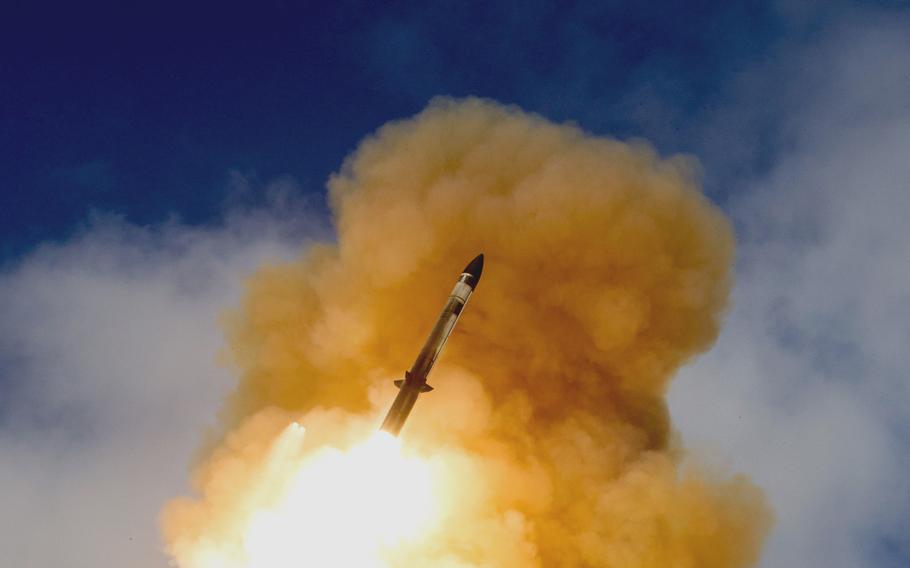
A U.S. Standard Missile-3 (SM-3) Block IIA first flew successfully from the Point Mugu Sea Range, San Nicolas Island, Calif., on June 2, 2015. (Ralph Scott/Missile Defense Agency)
TOKYO – The U.S. and Japan already have a high-flying interceptor they can improve to shoot down advanced weapons like hypersonic missiles, according to a missile-defense advocate.
The Pacific allies are working on an agreement to jointly develop a new kind of missile interceptor to defend against hypersonic weapons, Japan’s national broadcaster NHK reported Sunday.
U.S. President Joe Biden and Japanese Prime Minister Kishida Fumio may agree on a missile defense plan during Kishida’s visit to the U.S. that begins on Thursday, The Associated Press reported Tuesday.
Cooperation on hypersonic missile defense is a natural progression for the two allies, Riki Ellison, chairman of the Missile Defense Advocacy Alliance, based in Virginia, said by email Monday. The alliance lobbies for missile defense, deployment and development.
“Japan already builds the SM3 Block IIA (missile) with the United States in partnership and the defense against hypersonic glide will be launched off the SM3 Block IIA stages,” he said.
The U.S. and Japan jointly developed SM-3 Block IIA guided missiles between 2006 and 2017, a spokesperson for Japan’s Ministry of Defense said in an e-mail to Stars and Stripes on Monday.
The SM-3 is the next generation of the Aegis Weapon System and intercepts ballistic missiles midway in their flight path, according to the Center for Strategic and International Studies. “SM-3s are unique due to being the only Standard Missile designed to operate in the vacuum of space,” according to the center in Washington, D.C.
“In the U.S.-Japan 2-plus-2 meeting held in January of this year, we agreed to start discussions on the possibility of joint development of interceptors in the future in order to counter hypersonic technology and we are currently discussing the specifics,” the ministry spokesperson said.
China and Russia have already fielded hypersonic missiles. Russian forces have used them in battle during its war in Ukraine, the Pentagon has said.
Some Japanese government officials are required to speak to the press only on condition of anonymity.
“In any case, we will continue to consider the issue so that we can come to a conclusion as soon as possible,” the official wrote.
Japan’s defense budget this fiscal year totaling 6.82 trillion yen, or $51.4 billion, the nation’s largest ever, includes 211.3 billion yen, or $1.59 billion, to acquire U.S. Tomahawk missiles and 127.7 billion yen, about $963 million, to develop and manufacture improved surface-to-ship guided missiles.
Combining technological and financial resources is a good thing, said Grant Newsham, a retired Marine colonel and senior researcher with the Japan Forum for Strategic Studies in Tokyo.
“There is the problem that one or both sides may be reluctant to fully share what it’s got technology-wise, or it just might be slowed by bureaucratic or legal requirements - or even political obstacles,” he said by email Monday.
Cooperation on hypersonic missile defense would change the relationship between the U.S. and Japan, he said.
“You tend to view the other guy as a full ally whose doing his part,” he said. “That’ll be helpful in further building some more equality into the US-Japan defense relationship - that for too long had the Japanese pathologically dependent on the Americans.”
The project requires deeper linkages to US-Japan missile defense systems and command and control networks, he added.
“Both sides ought to join together for self-preservation if nothing else,” he said.